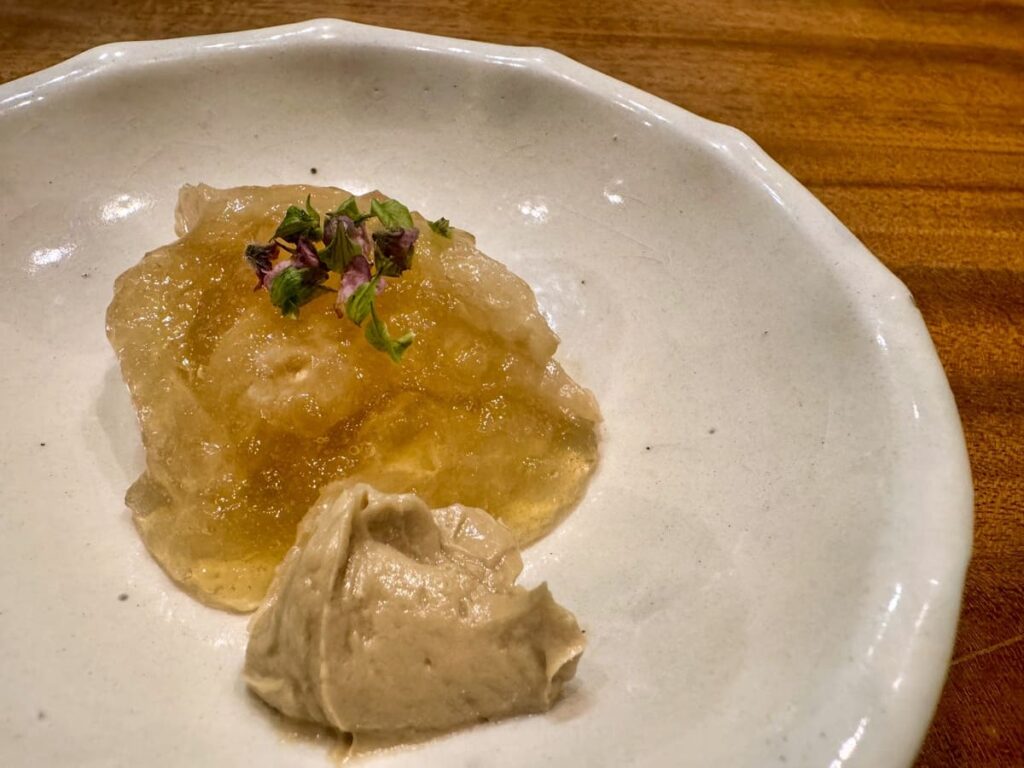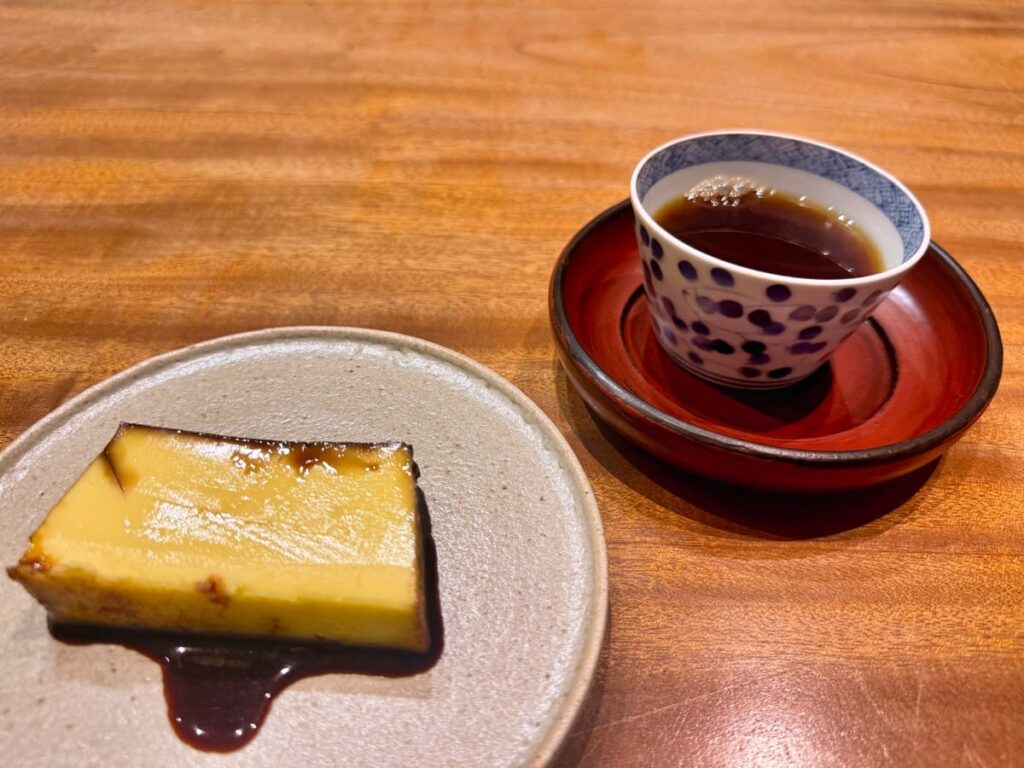毎年10店舗のみ、日本の食のトッププロが選んだ「本当に行く価値のあるレストラン」を海外に向けて発信するDestination Restaurants。ミシュランや食べログとは全然コンセプトが異なるこのグルメガイドで2022年の10店に選ばれた、広島・宮島口にお店を構えるAKAI(アカイ)というレストランに行ってきました。
このレストランがトッププロの目に留まった主な理由は、究極的なレベルで素材の味を引き出すことにこだわっていること。オーナーシェフの赤井顕治さんはフレンチ出身なのですが、一般的なフレンチのようにバターやソースで旨味を足していくのではなく、逆にできるだけ余計な味を削ぎ落としていくことで、食材のもつ味「だけ」を際立たせるようにメニューが考えられているんです。
そんな「引き算」的に構成された料理がどんな感じなのか?ものすごく興味があって、広島に行く用事ができた時に真っ先に時間を確保して席を予約。日本の食のプロが目をつけて海外に発信するほどのレストランですから、予約が取れた瞬間からずっと僕もワクワクでした…
特別な招待客のような気分になれます…新進気鋭のイノベーティブ・フュージョンレストラン・AKAIはこんなお店
今回ご紹介するAKAIは、JR宮島口から徒歩約8分のところにある高台で2019年に開業したレストラン。築80年の古民家をリノベーションして店舗利用していますが、実際にリノベーションしているのはエントランスと客席スペースのみで、それ以外の部分はほぼ手付かずのままで残されています。店頭を含めて駅からの動線には看板らしきものすら見当たらず、事前情報なしだと「本当にここがレストランなの?」って感じるはず。そんなわけで、初めて訪れる時にはGoogleマップやカーナビは必須です。
靴を脱いで中に入ると、真っ白な壁紙に張り替えられた明るく清潔感のあるダイニングスペースがありました。オープンキッチンになっていて、L字型のカウンターに沿って客席数は8席のみ。そんなこぢんまりしたお店をシェフと2名の女性スタッフで切り盛りしていました。お値段的には高級店ではありながら、すごく素朴でアットホームな雰囲気を感じますね。
メニューはランチ・ディナーともにおまかせコースのみ。コースの開始時間が決まっていて、その時間に一斉スタートになるので遅刻厳禁です。スタッフさんも専門のトレーニングを積んだプロの接客業の方ではなさそうで、予約時間以外にもあらゆる部分で都心部のレストランのようなフレキシブルな対応は困難です。でも、僕は逆にそこが「ここの8人だけ特別扱いでシェフにお迎えされている」ような気分になれて(思いっきり勘違いですが)すごく良かったですけどね…
日本屈指の観光地・宮島で食す「究極の引き算料理」…とある日のディナーで提供されたAKAIのおまかせコース全10品をご紹介
それでは早速、この日の僕がAKAIで食したおまかせコース全10品を順にご紹介していきましょう。コース料金はランチ・ディナー共通で1人税込16,500円(年末年始のみ税込22,000円/人に値上がりします)。高級店でありがちなサービス料などの追加料金はかかりませんが、当日注文のドリンク代のみ別途必要です。この日の僕は炭酸水を片手に料理をいただききましたが、ドリンクも日本酒やワインをはじめ各種揃っていて、料理に合わせてペアリングも可能なので、お気軽にシェフやスタッフさんに声をかけてみてください。
蕪と春菊のお吸い物

1品目はおまかせコースの最初にして、この日僕がAKAIで一番度肝を抜かれたメニュー「蕪と春菊のお吸い物」。何に度肝を抜かれたかというと、このお吸い物、多分出汁すらとっていないんですよ。このお椀の中に入っているのは、具材の蕪と春菊、そして水のみ(ちょっとだけ塩が入っているかも)と勝手に想像。つまり、蕪と春菊をほぼ水で煮ただけの、この上なくシンプルな一品なんです。
「そんな作り方をした料理が本当に美味いの?」と、きっとあなたは心の中で思っているでしょうね。その気持ちは僕もよくわかります。でもね、本当に美味いんですよ。蕪は茹でたじゃがいものようにホクホクで、春菊は軽く水分を含んで柔らかく、そしてその両者から滲み出たエキスが水の中に溶け込んで、薄味だけどじんわりと身体と心に響く味になったお吸い物…メディアではよく「素材の味を活かした」という表現が出てきますが、それを言うなら、僕はこの一杯を上回るほど「素材の味を活かした」料理におそらく出会ったことがありません。いや、「活かす」というか「素材の持つそのままの味を、直球ど真ん中で出した料理」と言う方がしっくり来ますね。とにかくこのお吸い物、今まで僕が食べてきた数々の料理の中でも「別格」です。
ウマヅラハギのお造り

2品目は広島・江田島で獲れたのウマヅラハギのお造り。ウマヅラハギの身には酸味のあるジュレがかかっていて、別に丁寧に裏漉しされた肝のペーストが添えられています。ウマヅラハギの身がプリップリで甘かったですね。ねっとり濃厚な旨みを持つ肝のペーストをつけてお造りを食べるのもいい感じ…
里芋の粕汁

3品目は里芋の粕汁。この粕汁もかなりあっさり目の味付けになっています。で、よく見ると粕汁の中に細かい柚子皮が浮かんでいるんですよね。粕汁の甘さに加えて、柚子皮の香りが口から鼻に向かってふわり…その繊細かつ優しい味に一口目でコロリとやられてしまいました。
一方、お椀の中央に浮かぶ里芋はそのままゴロっと入っているのではなく、一回丁寧に裏漉しされたものをだんご状に丸めて、さらに表面がパリッとなるまで炙ったものが入っています。表面の儚いながらもパリッとした感触と、中の裏漉しされた里芋のきめ細かさが、何だかよくわからないけど純日本的なものを思い起こさせてくれました。この粕汁で正月にお雑煮なんか作ったら、きっとものすごく美味いんだろうなぁ…
白甘鯛の酒蒸し

4品目はこれまた広島で獲れた高級魚・白甘鯛の酒蒸し。淡白でふわっとした白身魚に、黒酢ベース(?)の酸味がついた出汁がかかっています。魚の上にかかっているのは広島産のハーブと白胡麻。このハーブがコリアンダー系の強い香りを持っていたので、苦手な人にはちょっとキツかったかもしれません。
母豚と鴨もも肉のつくね

5品目は肉料理で、母豚と天然の鴨もも肉を使ったつくね。これが出てきた時「えっ、もう肉料理?」と少し焦りましたね。まだ5品目だし、コースのメインとしてはボリュームも少ないし…もしこの後に〆のご飯物が出てきたら、ここまでの高揚した気分が一転、かなりガッカリするところでした。
それはさておきこのつくね、めちゃくちゃ弾力があって肉肉しいんですよ。ミンチが荒めなのもワイルドさを感じさせてくれて、ナイフを入れると肉汁ドバドバ。で、このつくねに岩国れんこんを使った薄味のソースがたっぷりかかっているのですが、このソースがなくても濃厚な肉汁の旨味だけでペロリといけちゃいます。いや、むしろそんな濃厚な肉汁を吸収して味を中和させる目的でこのソースがかかっているのかも…「うますぎない味を目指す」AKAIの料理ですしね…そう考えるのは邪推しすぎかなぁ?
広島江田島産の牡蠣

出てきたものがご飯物じゃなくて一安心。6品目は、広島に来たならやっぱり一度は食べておきたい江田島産の牡蠣。薄味の醤油出汁の中央にプリッとした牡蠣が2粒、その上に大根おろしとミョウガ、ネギがたっぷりとかけられています。この1品は、コースの中でも箸休め的な存在でしょうか。牡蠣のミルキーな旨味を楽しむというよりは、大根おろしとミョウガでピリッと辛味を効かせて、この後の料理に備えて一旦口の中をリセットさせる…という感じの印象を受けました。
網獲り天然鴨の炭火焼き

7品目が本当のメインディッシュ、鹿児島で網獲りされた天然鴨の炭火焼き。これまでずっと和風の料理が続いていて、ここで初めてシェフの専門であるフレンチテイストの料理が出てきました。じっくり炭火で焼いた鴨肉に赤ワインソースという定番の組み合わせ。でも、この赤ワインソースも比較的あっさり目の味付けで、典型的なフレンチのメインディッシュとはやっぱり一味違います。
そして、鴨肉の方もやっぱり普通じゃありませんでした。というのは、見た目通り肉はレアなんですが、皮目にもほとんど焦げ目がついていなかったんです。なので炭火焼きならではの香ばしさもなく、口の中で広がるのはほぼ肉の旨味だけ。あまり適切な表現ではないかもしれませんが、肉食動物ってこんな感じで獲物の肉を食べているのかなぁ…って思いましたね。この焼き方、ただただ凄いな…
大根飯

8品目はコースの〆となるご飯物で大根飯。土鍋で炊いたご飯は粒がキリッと立っていて、やや硬めで歯応えを感じる炊き上がり。前もって炒めたものとお米と一緒に炊いたものの2種類の大根と青菜と柚子皮、白胡麻(キヌア?)が中に入っていて、江田島産のオリーブオイルをご飯の上にひとかけしてからいただきます。
この大根飯も、何だかよくわからないけど、ものすごい吸引力があるんですよね。決して濃い味を持っているわけではないし、むしろ一品目のお吸い物のようにほぼ具材の味だけで成り立っているような炊き込みご飯なのですが(強いて言えばオリーブオイルでしっとり感は出ているけど)、何で無性に惹きつけられたのか、このブログ記事を書いている段階でも不明です。そんな不思議な魅力(魔力?)がこの大根飯にはあって、実際他のお客さんも含めて全員この大根飯をおかわりしていました。
柚子のシャーベット

9品目は2種類出てくるデザートの1つ、柚子のシャーベット。過去に経験したことがないくらいすごく滑らかなシャーベットで、舌の上でサーっと溶けて柚子の風味を広げていくんですが、その中にチーズのようなコクも…
自家製プリンとコーヒー

そして最後の10品目は、自家製プリンとコーヒー。スプーンを入れる段階でかなりハードな感触が伝わってきます。味は過去一で卵が濃厚で、デザート前のコース料理とは打って変わって甘味もかなり強め。
上記、全10品で滞在時間は2時間ちょっと。強いブランド力を発揮している全国の有名イタリアン・フレンチレストランとは体験できるものが全然違いますが、僕個人的にはとっても幸せな時間を過ごすことができました。でも「はっきりとした旨味のインパクトがある」料理を提供するお店ではないので、その方向性が好みと合わない人もいるものと思われます。都会の高級店に匹敵するお値段を支払うので、後悔しないようにその点だけはしっかりと認識しておく必要があるのではないでしょうか。
強いて言えば調理のほとんどが奥の見えないところでされていたことには少し(いや、結構)残念でしたけどね。せっかくカウンターキッチンにしているので、実際にシェフが調理している姿を席から眺めていたかったな…
POCKET CONCIERGEを介してのネット予約が便利…AKAIへのアクセスは、最寄り駅のJR山陽本線・宮島口駅から徒歩8分
ここまで記事を読んで、もしあなたも「広島・宮島口のAKAIで究極の引き算料理を楽しみたい!」と思ったら、POCKET CONCIERGEを介してのネット予約が便利です。ここから予約を行えば、コース料金だけでなく当日注文したドリンク代も登録したクレジットカードから自動的に引き落とされるので、当日お店に財布を持っていく必要すら(多分)ありません。当日だけはお金のことを考えずに、シェフが作る料理に集中してみてはいかがでしょうか?POCKET CONCIERGE内の予約ページへのリンクを貼っておくので、よろしければぜひご利用ください。
それでは、お店の詳細です。店舗データはこちら…



 京菜味のむら 烏丸本店のお得なおばんざいモーニングを試してみた
京菜味のむら 烏丸本店のお得なおばんざいモーニングを試してみた
コメントを残す